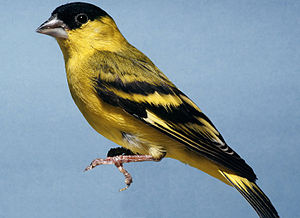Yarrell siskin
| Yarrell siskin | ||||||||||||
|---|---|---|---|---|---|---|---|---|---|---|---|---|

Yarrell siskin ( Spinus yarrellii ) |
||||||||||||
| Systematics | ||||||||||||
|
||||||||||||
| Scientific name | ||||||||||||
| Spinus yarrellii | ||||||||||||
| ( Audubon , 1839) |
The Yarrell siskin ( Spinus yarrellii , Syn .: Carduelis yarrellii ) is a South American finch species from the goldfinch subfamily . It was named after the British ornithologist William Yarrell .
description
This four-inch-tall bird stands out for its bright yellow color on its face and underside. The male has a black hood . The face, the base of the neck and the underside are colored light yellow. The light yellow olive top has dark olive stripes. The lower back is yellow. The wings are black with a yellow olive border on the wing covers and bright yellow wing bands, wing mirrors and umbrella feathers. The female has a yellow olive hood, the underside as well as the lower back are characterized by a more intense yellow color. The singing consists of complicated, varied, high and piercing trills.
Occurrence
Its distribution is limited to two areas in northern Venezuela and northeastern Brazil, which are 3500 km apart. In Brazil it is known from the following protected areas: Pedra Talhada ( Alagoas ), Serra Negra ( Pernambuco ), Saltinho Biological Reserves (Pernambuco), Serra da Capivara National Park ( Piauí ) and Tapacurá Ecological Station (Pernambuco). In Venezuela it is known from the southeastern Carabobo region. Little is known about his way of life. It inhabits the edges of secondary forests, but it can also be found on plantations, pastures and even populated areas at an altitude of up to 550 m above sea level.
Danger
The Yarrell siskin is a cage bird that is highly sought after by ornamental bird breeders. The bad habit of crossing different siskin species with each other (also known as mutation breeding) led to an impoverishment of the gene pool of this bird species in human care, which had to be compensated by more and more wild catches. This species is protected by Appendix II of the CITES Convention. In the 1980s, however, the illegal trade in this species began to boom, so that up to 100 birds per year could be found in some bird markets (e.g. the Caxias market in Rio de Janeiro ). Another reason for its exposure is the use of pesticides.
literature
- Peter Clement , Alan Harris, John Davis: Finches and Sparrows - An Identification Guide . Christopher Helm, London 1993, ISBN 0-7136-8017-2 .
Web links
- BirdLife factsheet - Yellow-faced Siskin (English)
- Spinus yarrellii inthe IUCN Red List of Threatened Species 2017.3. Listed by: BirdLife International, 2016. Retrieved January 25, 2018.